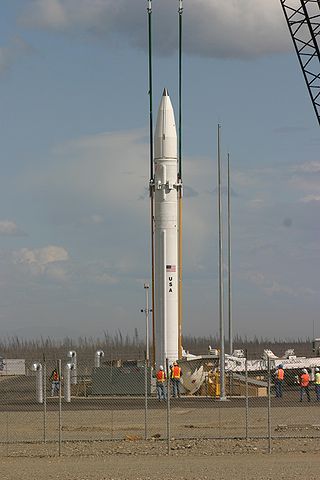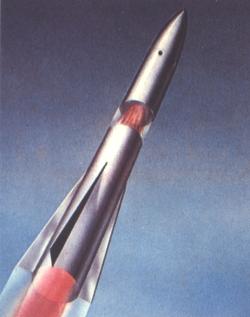Related Research Articles

An anti-ballistic missile (ABM) is a surface-to-air missile designed to counter ballistic missiles. Ballistic missiles are used to deliver nuclear, chemical, biological, or conventional warheads in a ballistic flight trajectory. The term "anti-ballistic missile" is a generic term for a system designed to intercept and destroy any type of ballistic threat; however, it is commonly used for systems specifically designed to counter intercontinental ballistic missiles (ICBMs).

A cruise missile is an unmanned self-propelled guided vehicle that sustains flight through aerodynamic lift for most of its flight path and whose primary mission is to place an ordnance or special payload on a target. Cruise missiles are designed to deliver a large warhead over long distances with high precision. Modern cruise missiles are capable of traveling at high subsonic, supersonic, or hypersonic speeds, are self-navigating, and are able to fly on a non-ballistic, extremely low-altitude trajectory.

An intercontinental ballistic missile (ICBM) is a ballistic missile with a range greater than 5,500 kilometres (3,400 mi), primarily designed for nuclear weapons delivery. Conventional, chemical, and biological weapons can also be delivered with varying effectiveness, but have never been deployed on ICBMs. Most modern designs support multiple independently targetable reentry vehicle (MIRVs), allowing a single missile to carry several warheads, each of which can strike a different target. The United States, Russia, China, France, India, the United Kingdom, Israel, and North Korea are the only countries known to have operational ICBMs.

A missile is an airborne ranged weapon capable of self-propelled flight aided usually by a propellant, jet engine or rocket motor.

A ballistic missile (BM) is a type of missile that uses projectile motion to deliver warheads on a target. These weapons are powered only during relatively brief periods—most of the flight is unpowered. Short-range ballistic missiles (SRBM) typically stay within the Earth's atmosphere, while most larger missiles are exo-atmospheric. The largest ICBMs are capable of full orbital flight. These weapons are in a distinct category from cruise missiles, which are aerodynamically guided in powered flight and thus restricted to the atmosphere.

The MGM-140 Army Tactical Missile System is a tactical ballistic missile designed and manufactured by the US defense company Ling-Temco-Vought (LTV), and later Lockheed Martin through acquisitions. It uses solid propellant, is 13 feet (4.0 m) long and 24 inches (610 mm) in diameter, and the longest-range variants can fly up to 190 miles (300 km). The missiles can be fired from the tracked M270 Multiple Launch Rocket System (MLRS) and the wheeled M142 High Mobility Artillery Rocket System (HIMARS).
Raytheon Missiles & Defense (RMD) was one of four business segments of RTX Corporation. Headquartered in Tucson, Arizona, its president was Wes Kremer. The business produced a broad portfolio of advanced technologies, including air and missile defense systems, precision weapons, radars, and command and control systems. Raytheon Intelligence & Space was merged with Raytheon Missiles & Defense in July 2023 to form the Raytheon business segment.

An intermediate-range ballistic missile (IRBM) is a ballistic missile with a range of 3,000–5,500 km, between a medium-range ballistic missile (MRBM) and an intercontinental ballistic missile (ICBM). Classifying ballistic missiles by range is done mostly for convenience. In principle there is very little difference between a low-performance ICBM and a high-performance IRBM, because decreasing payload mass can increase the range over the ICBM threshold. The range definition used here is used within the U.S. Missile Defense Agency.

The M270 Multiple Launch Rocket System is an American armored self-propelled multiple launch rocket system.

The Hatf I is a land-based tactical and battlefield range ballistic missile, currently in service with the strategic command of the Pakistan Army.

The MGM-52 Lance was a mobile field artillery tactical surface-to-surface missile system used to provide both nuclear and conventional fire support to the United States Army. The missile's warhead was developed at Lawrence Livermore National Laboratory. It was replaced by MGM-140 ATACMS, which was initially intended to likewise have a nuclear capability during the Cold War.

The RIM-161 Standard Missile 3 (SM-3) is a ship-based surface-to-air missile used by the United States Navy to intercept short- and intermediate-range ballistic missiles as a part of Aegis Ballistic Missile Defense System. Although primarily designed as an anti-ballistic missile, the SM-3 has also been employed in an anti-satellite capacity against a satellite at the lower end of low Earth orbit. The SM-3 is primarily used and tested by the United States Navy and also operated by the Japan Maritime Self-Defense Force.

Missile defense systems are a type of missile defense intended to shield a country against incoming missiles, such as intercontinental ballistic missiles (ICBMs) or other ballistic missiles. The United States, Russia, India, France, Israel, Italy, United Kingdom, China and Iran have all developed missile defense systems.

Project Wizard was a Cold War-era anti-ballistic missile system to defend against short and medium-range threats of the V-2 rocket type. It was contracted by the US Army Air Force in March 1946 with the University of Michigan's Aeronautical Research Center (MARC). A similar effort, Project Thumper, started at General Electric.

KN-24, officially the Hwasongpho-11Na, is a designation given to a North Korean single-stage, solid-fueled tactical ballistic missile.

The Ground Launched Small Diameter Bomb (GLSDB) is a weapon developed by Boeing and the Saab Group to allow Boeing's GBU-39 Small Diameter Bomb (SDB), originally developed for use by aircraft, to be ground-launched from a variety of launchers and configurations. It combines the SDB with the M26 rocket, enabling it to be launched from ground-based missile systems such as the M270 Multiple Launch Rocket System and M142 HIMARS.
References
- ↑ "The world's top air-to-surface missiles". November 2019.
- ↑ Wragg, David W. (1973). A Dictionary of Aviation (first ed.). Osprey. p. 254. ISBN 9780850451634.
- ↑ Mehta, Aaron (10 March 2015). "Boeing, Saab Unveil Ground Launched SDB". Defensenews.com. Retrieved 30 August 2017.
- ↑ "Ground-Launched Small Diameter Bomb (GLSDB)". Archived from the original on 2017-03-27. Retrieved 2017-03-26.
- ↑ "Ground-Launched Small Diameter Bomb (GLSDB)". Army-technology.com. Retrieved 30 August 2017.
- ↑ Osborn, Kris (6 September 2016). "US Army's New Ground-Launched Missile: Raining Down Death from 500 Kilometers Away". Nationalinterest.org. Retrieved 30 August 2017.
- ↑ "The Army Plans to Fire Its Version of the Navy's SM-6 Missile from This Launcher". 13 October 2021.
- ↑ "Roketsan - KARA ATMACA Surface-To-Surface Cruise Missile".